Nik Matthews, Head of the Imperial BRC Genomics Facility at Imperial College London discussed personal challenges he has come across in spatial genomics and potential resolutions. He kicked off his talk by highlighting how his team are using LeviCell. The LeviCell system uses a molecule to make dead or dying cells heavy, allowing them to be separated using a magnet. This system helps improve the viability of live cells for single-cell genomics.
For Matthews and his research group gDNA contamination has been a prominent problem when conducting bulk RNA sequencing. So, his group developed a tool using TURBO DNase to remove the contaminants, thus enhancing the quality of RNA-seq data. Most companies suggest having gDNA contamination of less than 2% which is a goal that Matthews is working towards.
GeoMx is often used by Matthews and his team, despite its strong capabilities in data analysis, there are issues when it comes to slides and staining. Matthews elaborated that tissues tend to overlap on the slides, and poor tissue adherence means that tissues may wash off the slide, leading to a significant amount of tissue sample loss. This ultimately leads to a loss of money.
Staining can highlight ROIs (regions of interest) but if not done carefully it can be hard to accurately identify ROIs so Matthews stressed the importance of proper tissue preparation and staining to obtain high-quality data. He suggested manual slide baking and optimized staining protocols, including reordering nuclear stains to preserve signal.
Additionally, Matthews introduced the BGI stereomics or Stereo-seq platform, which they are trying to use to tackle some issues around autofluorescence in brain tissue. “Snap-frozen” brain tissue complicates imaging and has a negative impact on data quality. The principal issue is the lack of an in-house microscope, which forces the team to transport slides to another building. This delay is highly likely to contribute to poor calibration. So, Matthews plans to install a microscope in-house and a robotic setup and explore future use of the CosMX platform to streamline workflows.





